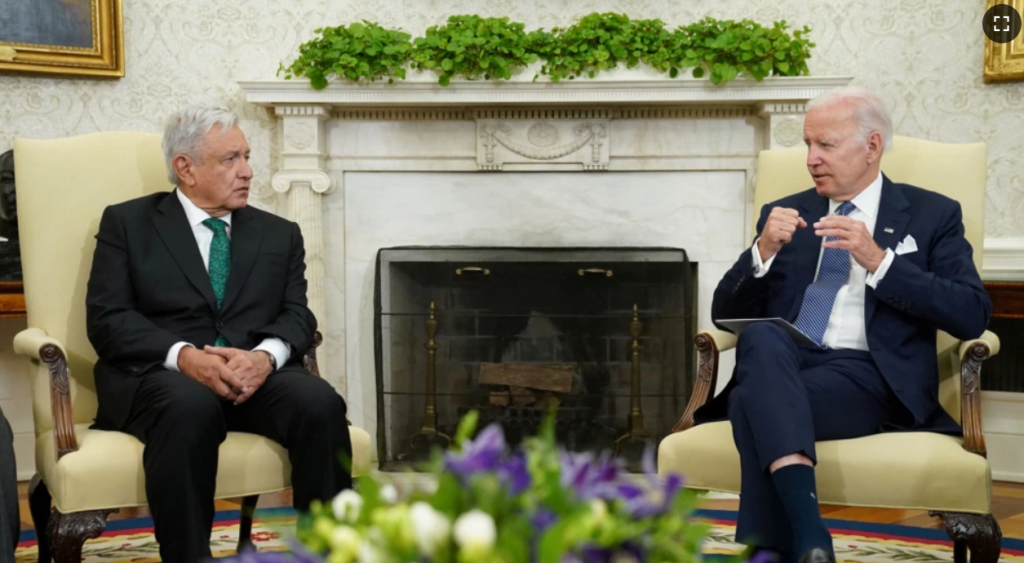
by Gilberto López y Rivas
Marxist analysis of a particular socioeconomic and political situation must not remain in the epidermal, anecdotal and phenomenal, but highlighting the essential and structural. To prevent the characters and, above all, their narratives –imposed by the mass media and social networks– from prevailing against the weight of class correlation, hegemonic systems, capitalist and imperialist forms of accumulation, exploitation and domination and neocolonial, as well as the processes of antisystemic struggle and resistance of the peoples and the working classes.
For this reason, AMLO’s recent trip to the United States and its results must be observed from the historical relationship of structural dependence of Mexico with respect to our “good neighbors”[the U.S.], the same one that has not been overcome by the government of the Fourth Transformation, which, in the bilateral meeting of presidents, committed to strengthening the North American Free Trade Agreement between Mexico, the United States and Canada, which the Permanent Peoples’ Tribunal considers —in its historic Final Hearing: Judgment, Prosecutors and Rapporteurships— to be marked by the profound inequality between the economies of the countries that signed it, and which, like other neoliberal institutions, is not designed to promote the social good, and on the contrary, “are agreements that elevate the legal status of large investors and, simultaneously, link the economic power of the State to their interests, while eroding the commitment and options of national states to protect the citizenry(…)”
“The transnational impunity that NAFTA governs allows us to affirm that it is a tremendously violent treaty. The structural violence of the capitalist system —which allows the accumulation of wealth of a few at the expense of poverty and the environmental and cultural destruction of peoples— is incorporated transversally throughout the treaty” (Editorial Ítaca, 2016). This characterization contrasts with the perspective on NAFTA in the joint communiqué, which argues that, “the foundation of North American competitiveness is the Mexico-United States-Canada Agreement and we reaffirm our commitment to its full implementation for the benefit of working families […] By coordinating our economic policies, we can make our supply chains more resilient and expand production in North America.” In the joint communiqué, Donald Trump’s claims that Mexico should pay for the border wall become a reality, as it discloses that Mexico has committed to invest 1.5 billion dollars in border infrastructure between 2022 and 2024.
It is also significant that, in the context of the repeated imposition of mega-projects in the territories by the current government, which recently declared the work on the Mayan Train a national security issue, the communiqué states: “We will focus our development efforts on climate solutions and the development of southern Mexico, with its vast human potential and important opportunities for trade, conservation and clean energy.
Other recent developments that reflect Mexico’s subordinate relationship with the United States did not go unnoticed. One of them was the U.S. Southern Command’s multinational military exercise in the Mexican Caribbean Sea, from May 7 to 21, called Tradewinds, and the other was the sixth Meeting of the Joint Chiefs of Staff of the Secretary of the Navy (Semar) and the U.S. Navy, in which 26 agreements were reached on operations, training, education, research and technological development, intelligence, surveillance and reconnaissance, electronic warfare and maritime traffic. The Semar declared that its relationship with the northern country is a priority and strategic. Last January, Jorge Alejandro Medellin announced that the Mexican Army and Navy were strengthening their ties with the U.S. Northern Command, with joint operative groups at the highest level, to fine-tune cooperation mechanisms in security areas of bilateral interest. In this regard, we recall the pioneering work by Carlos Fazio, El tercer vínculo: de la teoría del caos a la militarización (Joaquín Mortiz-Planeta, 1996) (The Third Link: From Chaos Theory to Militarization), which shows how Mexico became directly involved in the hemispheric security project headed by the United States. It is possible to consider that, with the militarization policies of the current government and the visibly subordinate role of the armed forces with respect to the Pentagon’s strategies, this third link of dependence in the military sphere, in addition to the economic and political ones, has been completed.
This article was published in La Jornada on June 22nd, 2022. https://www.jornada.com.mx/2022/07/22/opinion/016a1pol
English interpretation by Schools for Chiapas.
